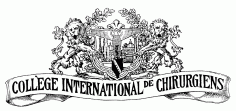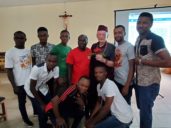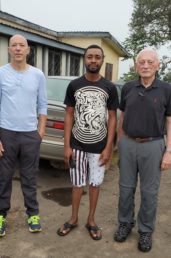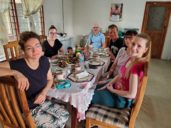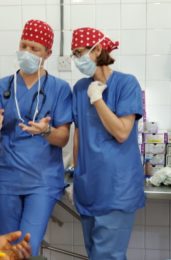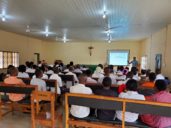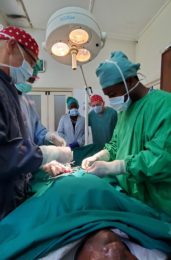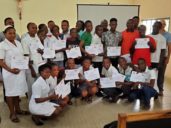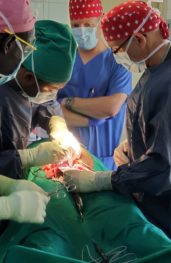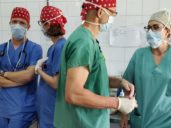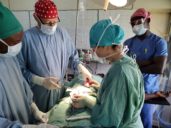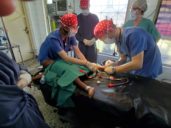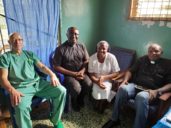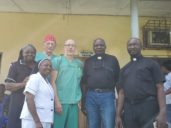MISSION: NIGERIA
Our 18th Mission to St. Mary's Hospital
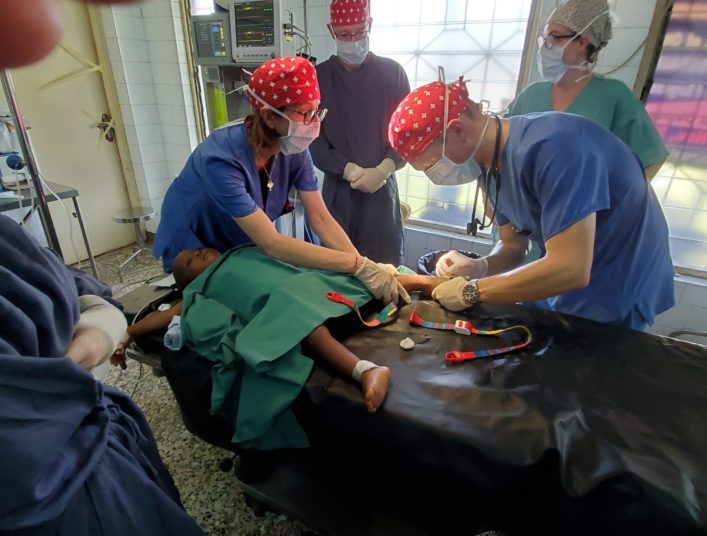
As the Executive Director of the International College of Surgeons, I write this enthusiastic report, as I had the opportunity and privilege from November 5-8, 2019, to be part of a Swiss humanitarian surgical team mission to St. Mary’s Hospital, Okpoga, Benue State, Nigeria, with the team led by Dr. Peter Nussbaumer, President of the ICS Swiss Section. In addition to Dr. Nussbaumer, the team members included another surgeon, Dr. Stepanka Senkyrova, a Fellow in the ICS Czech Republic Section; an anesthetist, Dr. Michael Minck; an anesthesia nurse, Annemarie Odermatt; a surgeon, Dr. Karoline Sromek; and a scrub nurse, Sanne Van Rijn; and, of course, myself, for a period of three days. The mission was the 18th mission to St. Mary’s Hospital, all led by Dr. Nussbaumer or experienced team leaders.
In ten days, this Swiss surgical team performed 146 procedures, held eight lectures, and administered a test at the conclusion of the visit to 49 staffers of St. Mary’s, with 28 staffers passing the test and receiving certificates in a ceremony, prior to “going back to work” in terms of doing more surgeries. All activities included, the team generally functioned from 7AM to 7PM at night. Each of team members paid their own respective on-ground expenses and took holiday time or unpaid leave to be a part of this team. This lay writer “followed Dr. Nussbaumer around” and observed 15 complete procedures from preparation, making the incision, to closure. The following is a summary list of what I observed in two full days:
- Seven groin hernias – mesh repair
- Abdominal tuberculosis – laparotomy adhesiolysis
- Fetal distress – C/S
- Hydrocele – resection
- Recurrent groin hernia – mesh repair
- Two pediatric hernia – suture repair
- Postpartum hemorrhage – suture vaginal tear
- Fibroid – hysterectomy (this patient, a 48 year old female, had an abdominal mass in the lower abdomen, with ultrasound showing the mass to be a massively enlarged uterus. During the laparotomy the necrotic mass disintegrated with significant blood loss, making the procedure very challenging for everybody. She stabilized and recovered in an uneventful manner.)
The Challenges
The team had little equipment, except for a malfunctioning diathermy machine and an old monitor. An anesthesia machine (Universal Anesthesia Machine UAM) was donated to the hospital prior to the mission and arrived just in time. For the first time the team was able to perform major surgeries under General Anesthesia and started to train local staff. There certainly were no “bells and whistles” in the surgical theater, making the knowledge of anatomy paramount. As seems to be so true in several facets of living life, we do not always need to have all of the “trinkets to do good and save lives or improve lives”. As Dr. Nussbaumer observed, providing humanitarian assistance in this type of environment is “back to the roots”.
So some readers of this report might ask "Max, why are you so enthusiastic"? Many reasons come to mind, perhaps too many to indicate in this report, so I will limit it to a few observations. The spirit of "giving back" and of improving the lives of patients, who otherwise most likely would not have their lives improved at all, and, perhaps not even live a longer life, is clearly uplifting . When one remembers and reflects on the billions of persons in surgical need on this planet, and seeing how these St. Mary’s patients responded (I saw this first hand when I did ward rounds with Dr. Nussbaumer), then you know the tremendous value being rendered by a humanitarian surgical team and the needs being addressed, that otherwise most likely would not be addressed, or, if addressed, the outcomes might not be good or as good. As one of the Reverend Sisters at St. Mary’s observed in reference to one procedure, if our people had done it, the patient "might not have made it".
The Team
In terms of the Swiss surgical team, I can, as a lay person, only express admiration and respect. The discipline in a very humble operating theater; the nature of the team work; the collegiality and respect amongst the team members, and, more importantly, the collegiality amongst the team members and the St. Mary’s staff; and the relationship between the Swiss team members and the leadership of St. Mary’s hospital were simply terrific!
Perhaps one of the most impressive “common threads” throughout all of the foregoing is the “sustainability factor”. The respect and collegiality amongst all of the team and hospital staff, the lectures followed by surgeries with St. Mary’s staff assisting, and the guidance and tutoring provided by the Swiss team are memorable in this writer’s mind and it indicates that, not only were difficult surgeries done (very challenging in reference to, for example, the hysterectomy), but these surgeries were performed by the “guiding hands” of the Swiss team and “gracious receipt”, yes, “gracious receipt”, by the St. Mary’s staff. It seems to me that, at least in part, this is what a surgical team is all about and what a surgical team should be. And the fact that this team is identified as an International College of Surgeons team is simply something in which every ICS Fellow should take great pride and satisfaction.
I strongly believe that this is the future of the International College of Surgeons and is completely “in line” with the founding philosophy of Dr. Max Thorek. This is why I am enthusiastic!
Respectfully submitted,

Max Downham
Executive Director
International College of Surgeons
NEXT STEPS
Join
If you're ready to join your fellow surgeons in the largest global community of your peers, click below to fill out an application!
Publish
We have most-respected peer-reviewed medical journal in the industry. Learn more on how to publish with us today!
Donate
Want to contribute to our ongoing projects and the international community of surgeons? Click below to make a donation!
Visit
North America’s only museum devoted to surgery is right here in Chicago. Learn more on how to visit by clicking the link below!
